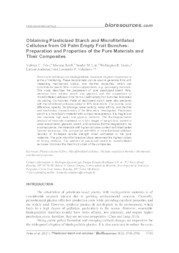Obtaining plasticized starch and microfibrillated cellulose from oil palm empty fruit bunches: preparation and properties of the pure materials and their composites.
Obtaining plasticized starch and microfibrillated cellulose from oil palm empty fruit bunches: preparation and properties of the pure materials and their composites.
Author(s): TELES, V. C.; ROLDI, M.; LUZ, S. M.; SANTOS, W. R. dos; ANDREANI, L.; VALADARES, L. F.
Summary: Abstract: Starch and celluloses are biodegradable resources of great importance in terms of marketing. These biopolymers can be used to generate films with interesting mechanical, optical, and thermal properties, which can substitute for plastic films in certain applications, e.g., packaging materials. This study describes the preparation of pure plasticized starch films, prepared from soluble starch and glycerol, and the preparation of microfibrillated cellulose films from oil palm empty fruit bunches fabricated via casting. Composites made of plasticized starch were also prepared with microfibrillated cellulose added in 10% increments. The density, color difference, opacity, morphology, water activity, water affinity, and thermal and mechanical characteristics of the films were investigated. Plasticized starch is a translucent material with contact transparency; it is fragile and has relatively high water and glycerol contents. The thermogravimetric analysis of materials displayed up to four stages of weight loss related to water evaporation, glycerol, starch, and cellulose thermal degradation. As a consequence, the materials with higher cellulose content exhibited better thermal resistance. The composites with 90% of microfibrillated cellulose resulted in increased tensile strength when compared to the pure materials. The pure microfibrillated cellulose presented the highest values of Young modulus. The addition of plasticized starch to microfibrillated cellulose improved the maximum strain of the composites.
Publication year: 2021
Types of publication: Journal article
Unit: Embrapa Agroenergy
Observation
Some of Embrapa's publications are published as ePub files. To read them, use or download one of the following free software options to your computer or mobile device. Android: Google Play Books; IOS: iBooks; Windows and Linux: Calibre.
Access other publications
Access the Agricultural Research Database (BDPA) to consult Embrapa's full library collection and records.
Visit Embrapa Bookstore to purchase books and other publications sold by Embrapa.

